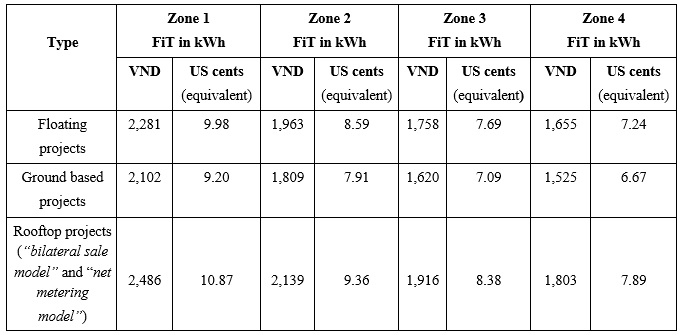Draft changes to solar power regulations
 |
| Vaibhav Saxena |
This decision is intended to be approved and take effect from July 1, 2019 replacing the current Decision 11 of the prime minister which took effect on June 1, 2017. Vaibhav Saxena, lawyer at Vietnam International Law Firm, gives deep analysis into its possible impacts on the market.
Feed-in-Tariff (FiT) and foreign exchange rate
Currently, Decision 11 provides for the FiT of 9.35 US cents per kWh for the solar power projects that achieve commercial operation date (COD) by June 30, 2019. In case of Ninh Thuan province only, under Resolution 115 of the government dated August 31, 2018, the solar power projects with design capacity of 2,000MW approved by the prime minister and COD by the end of 2020 are also entitled to the above FiT of 9.35 US cent per kWh (exclusive of VAT and following the central VND/USD exchange rate of Vietnam announced by the State Bank of Vietnam on 10 April 2017, i.e, VND 22,316 = 1 USD). The FiT shall not remain the same and shall be adjusted to fluctuations of the central VND/USD exchange rate. FiT are calculated in US cents per kWh and the applicable FiT rate shall be the central VND-USD exchange rate announced by the State Bank of Vietnam on the invoice issuing date by the seller.
The draft decision provides for specific levels of tariff structure applicable to the solar power projects achieving the COD deadline between July 1, 2019 and December 31, 2021. The draft decision further categorises the tariff levels based on four zones (see box below), depending on the solar irradiation levels and solar technologies used.
Tabular presentation of the FiT levels:
 |
| Note: The FiT exchange rate in the above table is calculated based on the central VND/USD exchange rate announced by the State Bank of Vietnam on December 9, 2018 |
Three categories of solar power projects
i. Grid-connected floating solar projects, which are projects having solar panels deployed on constructed structure and floating on the water surface;
ii. Grid-connected ground-mounted projects, which are projects having panels deployed on constructed ground structure, also includes grid-connected rooftop solar projects or attached to a building that have an installed capacity of more than 1 MWp; and
iii. Rooftop projects are the ones having panels deployed on the roof, or attached to a building both with an installed capacity of 1 MWp or less and connected directly or indirectly to the national power grid.
Offtake obligation vs. grid capacity
The electricity purchaser is defined as Vietnam Electricity (EVN) or affiliated entity, being authorized by EVN or other organisations or individuals purchasing electricity from the electricity seller or receiving the rights and obligations of the above-mentioned organisations as per the regulations of the law. This is a new development that allows entities other than EVN and EVN-affiliated entities to purchase the electricity.
The electricity purchaser is responsible for off-taking all the electricity output generated by the relevant grid-connected solar power project to the extent permitted by the grid.
Article 6(1) of the draft decision imposes the responsibility on the electricity seller to make investment, installation, operation, and maintenance of power metering equipment, transmission lines, and substations booster (if any) from the solar power plant to the connection point of the grid of the electricity buyer. It also makes the seller responsible for organising the verification and calibration, test power metering equipment in accordance with the law on measurement.
Power Purchase Agreement (PPA) term
The term of a grid-connected solar PPA shall be 20 years from the COD, which could be extended or renewed at the end of the term, subject to agreement of the relevant parties and the-then laws of Vietnam.
Solar rooftop
The draft decision extends the scope of rooftop solar projects by defining Direct Electricity Selling and Purchasing model as a model in which individuals and organisations that invest, produce, and sell electricity from rooftop solar power projects to other individuals and organisations that are not connected to and do not utilise the national grid for electricity supply (the Model). Investors opting for the Model are permitted to agree mutually on the electricity tariff and the contents of the power purchase agreement in accordance with the current regulations on civil and commercial acts. Further, the draft decision includes a provision for selling any excess electricity to the national grid produced by the project using the Model, in accordance with the FiT scheme as detailed thereunder and the Model PPA that will be released by the MoIT.
The new provision of the draft decision is to comply with the direct power purchase agreement (DPPA) regime that has been worked out by the consultants of the Electricity Regulatory Authority of Vietnam (ERAV) and is expected to enter into force in 2019. However, the threshold for solar projects not included in the master planning sticks to 1MWp and the Model requires further guidance on its implementation.
Zonal divisions for FiT
Zone 1: consisting of 28 provinces from the north of Vietnam, namely: Ha Giang, Bac Kan, Cao Bang, Tuyen Quang, Thai Nguyen, Lao Cai, Yen Bai, Lang Son, Quang Ninh, Phu Tho, Vinh Phuc, Bac Giang, Hai Duong, Hoa Binh, Hanoi, Ha Nam, Bac Ninh, Hung Yen, Haiphong, Ninh Binh, Thai Binh, Ha Tinh, Nam Dinh, Quang Binh, Thanh Hoa, Lai Chau, Nghe An, and Son La.
Zone 2: consisting of 6 provinces of Vietnam, namely: Quang Tri, Dien Bien, Thua Thien Hue, Quang Nam, Danang, and Quang Ngai.
Zone 3: consists of 23 provinces from the south of Vietnam, namely: Kon Tum, Ca Mau, Hau Giang, Binh Dinh, Bac Lieu, Kien Giang, Soc Trang, Can Tho, Vinh Long, Tra Vinh, Lam Dong, Ben Tre, Tien Giang, An Giang, Dak Nong, Ho Chi Minh City, Dong Nai, Dong Thap, Ba Ria-Vung Tau, Long An, Binh Duong, Binh Phuoc, and Tay Ninh.
Zone 4: consists of 6 provinces of Vietnam, namely: Phu Yen, Gia Lai, Dak Lak, Khanh Hoa, Ninh Thuan, and Binh Thuan.
Transitional provisions
The draft decision does not have the transitional provisions dealing with the projects that have been developed under Decision 11, particularly those which have been licensed under Decision 11 but have not achieved COD by June 30, 2019, or with respect to projects in Ninh Thuan province, by the end of 2020.
What the stars mean:
★ Poor ★ ★ Promising ★★★ Good ★★★★ Very good ★★★★★ Exceptional
Related Contents
Latest News
More News
- Main drivers for Vietnam’s digital economy future (December 03, 2025 | 11:35)
- Pivotal stage of growth paves way for rise in M&As (December 03, 2025 | 10:00)
- Positive projections for M&A interest from Thailand (December 03, 2025 | 09:40)
- Manifesting the first line of defence in cybersecurity (December 03, 2025 | 09:00)
- The transformational role AI can play in accounting arena (December 03, 2025 | 08:00)
- Unlocking 5G-AI potential in Singapore (December 03, 2025 | 08:00)
- Data-driven strategies vital for a fast-evolving nation (December 02, 2025 | 09:41)
- Policy to practice: how Vietnam can lead the region (November 26, 2025 | 16:03)
- Mobilising private capital at scale vital for climate battle (November 26, 2025 | 15:36)
- VILAF and Yoon & Yang launch Vietnam - Korea Practice Unit (November 26, 2025 | 15:16)

 Tag:
Tag:




















 Mobile Version
Mobile Version